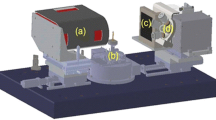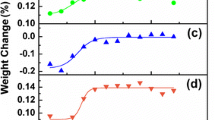Abstract
Nuclear graphite that can be used in molten salt reactors, one of the main types of fourth-generation nuclear reactors, has the properties of high purity, high density, and radiation resistance, and it also has a special pore structure that prevents infiltration of the molten salt fuel. The nuclear graphites IG-110, NBG-18, and NG-CT-50 were characterised using X-ray computed tomography (CT) to understand their internal pore structures. The porosities, isolated pore volumes, and connected pore volumes were obtained. The average diameter of connected pores in IG-110, NBG-18, and NG-CT-50 were 9.9, 10.4 and 9.5 μm, respectively, but the nuclear graphite NBG-18 had the broadest diameter range for connected pores, with many of > 25 μm. To further analyse the connected pores, pore throat networks were established based on the connected porosities. The pore throats, channel lengths, and coordination numbers of the connected pores were herein quantitatively analysed. Among IG-110, NBG-18, and NG-CT-50, the average diameters of the throats were 4.5, 5.2, and 4.6 μm, and the peak throat diameters were 1.8, 2.6, and 1.2 μm, respectively, but the NBG-18 pore throat distribution also included multiple peaks at larger diameters (16–20 μm), which was consistent with findings from the mercury intrusion test. Our statistics based on the pore throat networks suggested that NBG-18 is the most easily infiltrated by molten salt among the three nuclear graphite samples, while NG-CT-50 is the most difficult. The quantitative information from the pore throat modelling could be a basis for future studies on liquid flow simulations inside graphite.
Graphic Abstract








Similar content being viewed by others
References
Allen, T.R., Sridharan, K., Tan, L., Windes, W.E., Cole, J.I., Crawford, D.C., Was, G.S.: Materials challenges for generation IV nuclear energy systems. Nucl. Technol. 162, 342–357 (2008)
Kelly, B.T.: The Physics of Graphite. Applied Science Publishers, London (1981)
Babout, L., Mummery, P.M., Marrow, T.J., Tzelepi, A., Withers, P.J.: The effect of thermal oxidation on polycrystalline graphite studied by X-ray tomography. Carbon 43, 765–774 (2005)
E.P. Wigner, Report for Month Ending December 15, U.S. Atomic Energy Commission Report CP-387 (1942)
R.J. Sheil, R.B. Evans, G.M. Watson: Molten Salt-Graphite Compatibility Test. Results of Physical and Chemical Measurements, Oak Ridge National Laboratory, ORNL-59-8-133 (1959)
He, Z., Gao, L., Wang, X., Zhang, B., Qi, Q., Song, J., He, X., Zhang, C., Tang, H., Xia, H., Zhou, X.: Improvement of stacking order in graphite by molten fluoride salt infiltration. Carbon 72, 304–311 (2014)
Karthik, C., Kane, J., Butt, D.P., Windes, W.E., Ubic, R.: In situ transmission electron microscopy of electron-beam induced damage process in nuclear grade graphite. J. Nucl. Mater. 412, 321–326 (2011)
Krishna, R., Jones, A.N., McDermott, L., Marsden, B.J.: Neutron irradiation damage of nuclear graphite studied by high-resolution transmission electron microscopy and Raman spectroscopy. J. Nucl. Mater. 467, 557–565 (2015)
Wen, K.Y., Marrow, T.J., Marsden, B.J.: The microstructure of nuclear graphite binders. Carbon 46, 62–71 (2008)
Huang, Q., Li, J.J., Liu, R.D., Yan, L., Huang, H.F.: Surface morphology and microstructure evolution of IG-110 graphite after xenon ion irradiation and subsequent annealing. J. Nucl. Mater. 491, 213–220 (2017)
Freeman, H.M., Mironov, B.E., Windes, W., Alnairi, M.M., Scott, A.J., Westwood, A.V.K., Brydson, R.M.D.: Micro to nanostructural observations in neutron irradiated nuclear graphites PCEA and PCIB. J. Nucl. Mater. 491, 221–231 (2017)
Zheng, G.Q., Xu, P., Sridharan, K., Allen, T.: Characterization of structural defects in nuclear graphite IG-110 and NBG-18. J. Nucl. Mater. 446, 193–199 (2014)
Huang, W.H., Tsai, S.C., Yang, C.W., Kai, J.J.: The relationship between microstructure and oxidation effects of selected IG- and NBG-grade nuclear graphites. J. Nucl. Mater. 454, 149–158 (2014)
Berre, C., Fok, S.L., Mummery, P.M., Ali, J., Marsden, B.J., Marrow, T.J., Neighbour, G.B.: Failure analysis of the effects of porosity in thermally oxidised nuclear graphite using finite element modelling. J. Nucl. Mater. 381, 1–8 (2008)
Vertyagina, Y., Marrow, T.J.: 3D cellular automata fracture model for porous graphite microstructures. Nucl. Eng. Des. 323, 202–208 (2017)
Jing, S.P., Zhang, C., Pu, J., Jiang, H.Y., Xia, H.H., Wang, F., Wang, X., Wang, J.Q., Jin, C.: 3D microstructures of nuclear graphite: IG-110, NBG-18 and NG-CT-10. Nucl. Sci. Technol. 27, 66 (2016)
Babout, L., Marsden, B.J., Mummery, P.M., Marrow, T.J.: Three-dimensional characterization and thermal property modelling of thermally oxidized nuclear graphite. Acta Mater. 56, 4242–4254 (2008)
Barhli, S.M., Saucedo-Mora, L., Jordan, M.S.L., Cinar, A.F., Reinhard, C., Mostafavi, M., Marrow, T.J.: Synchrotron X-ray characterization of crack strain fields in polygranular graphite. Carbon 124, 357–371 (2017)
Xie, H.L., Deng, B., Du, G.H., Fu, Y.N., Chen, R.C., Zhou, G.Z., Ren, Y.Q., Wang, Y.D., Xue, Y.L., Peng, G.Y., He, Y., Guo, H., Xiao, T.Q.: Latest advances of X-ray imaging and biomedical applications beamline at SSRF. Nucl. Sci. Technol. 26, 020102 (2015)
Gao, Y.T., Wang, Y.D., Yang, X.M., Liu, M., Xia, H.H., Huai, P., Zhou, X.T.: Synchrotron X-ray tomographic characterization of CVI engineered 2D-woven and 3D-braided SiCf/SiC composites. Ceram. Int. 42, 17137–17147 (2016)
Peth, S., Horn, R., Beckmann, F., Donath, T., Fischer, J., Smucker, A.J.M.: Three-dimensional quantification of intra-aggregate pore-space features using synchrotron-radiation-based microtomography. Soil Sci. Soc. Am. J. 72(4), 897–907 (2008)
Hu, X.F., Wang, L.B., Xu, F., Xiao, T.Q., Zhang, Z.: In situ observations of fractures in short carbon fiber/epoxy composites. Carbon 67, 368–376 (2014)
Zhang, D.S., Xia, H.H., Yang, X.M., Feng, S.L., Song, J.L., Zhou, X.T.: The influence of FLiNaK salt impregnation on the mechanical properties of a 2D woven C/C composite. J. Nucl. Mater. 485, 74–79 (2017)
W. Windes, T. Burchell, R. Bratton: Graphite Technology development plan, INL/EXT-07-13165, September 2007 (2007).
Tang, H., Qi, W., He, Z.T., Xia, H.H., Huang, Q., Zhang, C., Wang, X., Song, J.L., Huai, P., Zhou, X.T.: Infiltration of graphite by molten 2LiF–BeF2 salt. J. Mater. Sci. 52, 11346–11359 (2017)
Nightingale, R.E.: Nuclear Graphite. Academic Press, New York (1962)
Zheng, G.Q., Xu, P., Sridharan, K., Allen, T.R.: Pore structure analysis of nuclear graphite IG-110 and NBG-18. Adv. Mater. Sci. Environ. Nucl. Technol. II(227), 251–260 (2011)
Chen, R.C., Dreossi, D., Mancini, L., Menk, R., Rigon, L., Xiao, T.Q., Longo, R.: PITRE: software for phase-sensitive X-ray image processing and tomography reconstruction. J. Synchrotron Radiat. 19, 836–845 (2012)
Oh, W., Lindquist, W.B.: Image thresholding by indicator kriging. IEEE Trans. Pattern Anal. 21, 590–602 (1999)
Lindquist, W.B., Venkatarangan, A.: Pore and throat size distributions measured from synchrotron X-ray tomographic images of Fontainebleau sandstones. J. Geophys. Res. 105, 21509–21527 (2000)
Acknowledgements
This work was supported by the National Natural Science Foundation of China (Grant Nos. 11505273, and 11805261), the Joint Funds of the National Natural Science Foundation of China (Grants U1832152 and U1632268) and the National Key Research and Development Program (No. 2017YFA0402800). We acknowledge the beam time provided by 13W beamline at Shanghai Synchrotron Radiation Facility (SSRF) for the CT measurements.
Author information
Authors and Affiliations
Corresponding authors
Ethics declarations
Conflict of interest
The authors declare no competing financial interests.
Additional information
Publisher's Note
Springer Nature remains neutral with regard to jurisdictional claims in published maps and institutional affiliations.
Rights and permissions
About this article
Cite this article
Zhu, Y., Huang, Q., Li, C. et al. Pore Structure of Nuclear Graphite Obtained via Synchrotron Computed Tomography. J Nondestruct Eval 39, 17 (2020). https://doi.org/10.1007/s10921-020-0659-5
Received:
Accepted:
Published:
DOI: https://doi.org/10.1007/s10921-020-0659-5




